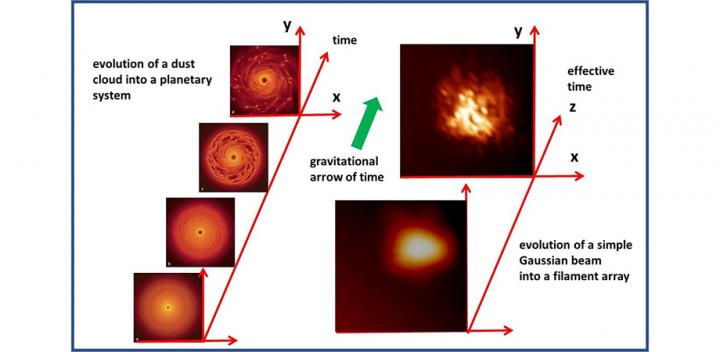Hyperbolic metamaterials exhibit 2T physics

Comparison of gravitational and optical behavior. V. Smolyaninova et al.
Credit: V. Smolyaninova et al., doi 10.1117/1.AP.2.5.056001
3D nonlinear ferro-fluid-based hyperbolic metamaterials may contribute to ultra-fast all-optical hyper-computing.
Metamaterials–nanoengineered structures designed for precise control and manipulation of electromagnetic waves–have enabled such innovations as invisibility cloaks and super-resolution microscopes. Using transformation optics, these novel devices operate by manipulating light propagation in “optical spacetime,” which may be different from the actual physical spacetime.
According to Igor Smolyaninov of the University of Maryland, “One of the more unusual applications of metamaterials was a theoretical proposal to construct a physical system that would exhibit two-time physics behavior on small scales.” That proposal was recently realized experimentally by demonstration of two-time (2T) behavior in ferro-fluid-based hyperbolic metamaterials by Smolyaninov and a team of researchers from Towson University, led by Vera Smolyaninova. The observed 2T behavior has potential for use in ultrafast all-optical hypercomputing.
2T physics
The familiar three spatial dimensions and one temporal dimension of conventional spacetime find an alternative paradigm in 2T physics, which has two spatial and two temporal dimensions. Pioneered through theoretical investigation and modeling by physicists Paul Dirac and Andrei Sakharov in the 1960s, 2T space-time was more recently explored by Smolyaninov with Evgenii Narimanov of Purdue University. Their theoretical model predicted that light waves might exhibit 2T behavior in hyperbolic metamaterials.
Nonlinear hyperbolic metamaterials for precision light control
Hyperbolic metamaterials are extremely anisotropic, behaving like a metal in one direction and like a dielectric in the orthogonal direction. Originally introduced to improve optical imaging, hyperbolic metamaterials demonstrate a number of novel phenomena, such as very low reflectivity, extreme thermal conductivity, high temperature superconductivity, and interesting gravity theory analogues.
Smolyaninov explains that the gravity analogues are a coincidental mathematical parallel: the mathematical equations that describe propagation of light in hyperbolic metamaterials also describe particle propagation in the physical, or Minkowski, spacetime in which one of the spatial coordinates behaves as a “time-like variable.”
Smolyaninov explains further that nonlinear optical effects “bend” this flat Minkowski spacetime, resulting in “effective gravitational force between extraordinary photons.” According to Smolyaninov, experimental observation of the effective gravity in such a system should enable observation of the emergence of the gravitational arrow of time along a spatial direction. Together with conventional physical time, the two time-like variables guide evolution of the light field in a hyperbolic metamaterial.
Experimental progress in this exciting field has been relatively slow until recently, due to difficulties associated with the 3D nanofabrication techniques necessary to produce large-volume 3D nonlinear hyperbolic metamaterials.
The research team developed an alternative way to fabricate large-volume 3D nonlinear hyperbolic metamaterials using self-assembly of magnetic metallic nanoparticles in a ferrofluid subjected to external magnetic field. Smolyaninov explains, “Due to nonlinear optical Kerr effect in the strong optical field of a CO2 laser, light propagating inside the ferrofluid indeed exhibits pronounced gravity-like effects, leading to emergence of the gravitational arrow of time.”
As predicted by the earlier theoretical work, the experimentally observed dynamics of self-focused light filaments may indeed be described mathematically using the 2T physics model.
Ultrafast all-optical hypercomputing
According to Smolyaninov, ultrafast all-optical hypercomputing involves mapping a computation performed during a given period of time onto a much faster computation performed using a given spatial volume of a hyperbolic metamaterial–a possibility enabled by the observed 2T behavior. Smolyaninov notes that hypercomputing schemes may be useful in time-sensitive applications, such as real-time computing, flight control, or target recognition.
###
Read the original research article by Vera Smolyaninova et al., “Experimental observation of effective gravity and two-time physics in ferrofluid-based hyperbolic metamaterials,” Adv. Photonics, 2(5), 056001 (2020), doi 10.1117/1.AP.2.5.056001.
Media Contact
All latest news from the category: Information Technology
Here you can find a summary of innovations in the fields of information and data processing and up-to-date developments on IT equipment and hardware.
This area covers topics such as IT services, IT architectures, IT management and telecommunications.
Newest articles

You are What You Eat—Stanford Study Links Fiber to Anti-Cancer Gene Modulation
The Fiber Gap: A Growing Concern in American Diets Fiber is well known to be an important part of a healthy diet, yet less than 10% of Americans eat the minimum recommended…

Trust Your Gut—RNA-Protein Discovery for Better Immunity
HIRI researchers uncover control mechanisms of polysaccharide utilization in Bacteroides thetaiotaomicron. Researchers at the Helmholtz Institute for RNA-based Infection Research (HIRI) and the Julius-Maximilians-Universität (JMU) in Würzburg have identified a…

ASXL1 Mutation: The Hidden Trigger Behind Blood Cancers and Inflammation
Scientists show how a mutated gene harms red and white blood cells. LA JOLLA, CA—Scientists at La Jolla Institute for Immunology (LJI) have discovered how a mutated gene kicks off…



